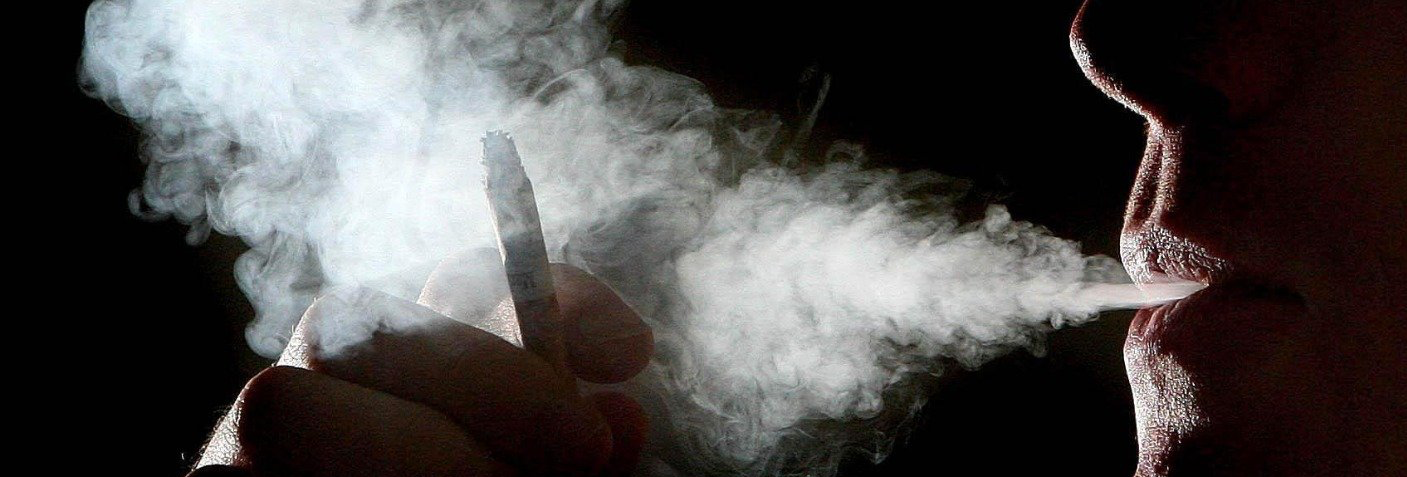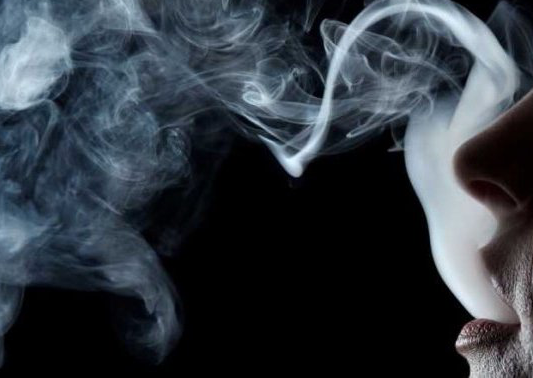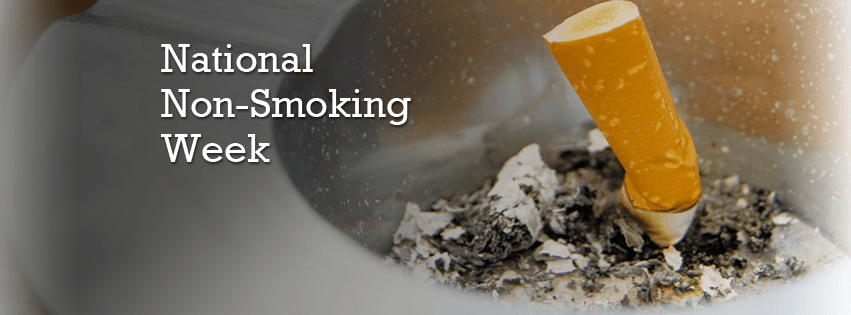


NEWS
Stay up to date on the latest news related to smoke-free housing policies and second-hand smoke in BC and across the country.

December 1, 2023
November 23, 2023 - Cool Aid, which operates the Tally Ho facility on Douglas Street, says measures are being put in place to reduce the smoke and protect staff. Darron Kloster , Times Colonist A supportive-housing facility in Victoria was found to have unacceptable levels of illicit substances in the air, putting staff and other residents at risk. According to a letter circulated to staff and obtained by CHEK News , Cool Aid, which operates the Tally Ho facility on Douglas Street, said measures are being put in place to reduce the smoke and protect staff. It said visitors are no longer permitted on the property and security has been hired to enforce the policy.Cool Aid staff will also be wearing respirators. The letter also said smoking is only allowed in designated areas and those who continue to smoke in their rooms will be given notices that will end in evictions. Fencing is being installed in front of the building to deter non-residents from hanging around, the letter said, adding the amount of smoke coming in from the front vestibule is “highly contributing” to air quality inside the building. “We need to continue to take significant measures to ensure we can operate and keep everyone safely housed,” the letter added. “To put it bluntly, if we don’t have staff, we don’t have a building.” The letter advised residents not to take out their frustrations on staff “who are just doing their jobs.” WorkSafeBC told the Times Colonist it is aware of the issue and is working on specific site issues with Cool Aid. In an emailed statement, WorkSafeBC said employers must take steps to protect their workers from exposure to second-hand smoke from unregulated drugs or any other source. "Employers are responsible for ensuring a risk assessment is conducted by a qualified person to determine what the exposure levels of unregulated substances are at their site and putting controls in place.” The agency pointed out that workers in the province have the right to refuse unsafe work, citing the Occupational Health and Safety Regulation that spells out the right of a worker to refuse work if there is reasonable cause to believe it would create an undue hazard to their health and safety.

November 20, 2023
November 14, 2023 - 'We have no rights': Couple seeks ban on secondhand smoke seeping in from neighbour's shared wall National Post: Sharon Kirkey Taes Leavitt and Peter Katz, Juno-recognized musicians, say it often feels 'unsafe' to be in their own home View video Taes Leavitt has a closet full of clothes that have a lingering cigarette stench. Her living room and bedroom often smell like an “ashtray,” the level of stale secondhand smoke hanging so heavy in the air it often wakes her and her partner, Peter Katz, at night. They don’t smoke, but their neighbour, with whom they share a common wall, does. The secondhand smoke wafting in from next door is making the lives of the Juno-recognized musicians and motivational speakers miserable, and they’re preparing to appeal to the City of Toronto to enact a bylaw preventing “home-to-home” transmission of secondhand smoke. “You have two young Ontario citizens who are being forced to live in a level of toxic smoke spread from a neighbour,” their submission to city council reads. “You have to do something immediately to resolve this danger.” They aren’t alone. Secondhand smoke wafting from one residence to another through walls, air ducts, cracked floors, plumbing and electrical systems, patios, balconies and other points of entry is a common problem across the country, said Rob Cunningham, a senior policy analyst at the Canadian Cancer Society. “It’s an important health issue and it needs a solution.” Ontario’s Smoke-Free Ontario Act, like other provincial laws, prohibits smoking and vaping in all enclosed workplaces and public places. People can’t smoke within nine metres of the entrance or exit of a public building. People can’t smoke in bars, restaurants or “select outdoor spaces.” Most hotel rooms, university dormitories and prisons — other places of “residence” — are also smoke-free. There are no laws, however, prohibiting smoking in private dwellings, though landlords and condominium and co-op boards may enact their own private no-smoking rules. Cunningham said that, in the same way that people can lodge a bylaw complaint about a neighbour making excessive noise — people are entitled to their “quiet enjoyment,” he said — “your neighbour shouldn’t be putting toxic, carcinogenic substances into your home. And that’s what’s happening.” But it’s a complex issue. How to ensure individual freedoms don’t conflict? What I do in my home is my business. ANTOINETTE CUOZZO, NEIGHBOUR Leavitt and Katz’s neighbour said she is entitled to do whatever she so wishes within in her own home. “What I do in my home is my business,” Antoinette Cuozzo said when reached by National Post. “I don’t hurt people. I don’t libel people, or anything else. All of this is stepping out of boundaries. This gaslighting stops,” she said, before hanging up. Katz agrees that people have the right to smoke. “But you’re not allowed to have your smoke enter people’s lungs against their will.” He was hospitalized with a lung condition in his 20s and still has chest pain from time to time that can be aggravated by smoke. He said he doesn’t wish Cuozzo any ill will. However, he’s been monitoring and recording air quality inside their west-end Toronto rowhouse during the on-and-off smoke drifts, using a device that measures particulate matter. “The machine is like a smart machine — it gives you messages,” Katz said. “Sometimes it says, ‘Get out of your house.’ Or ‘dangerous levels. Get outside.’ It just freaks out.” The dangers of secondhand smoke are well-known. Health Canada recently announced it will be printing “poison in every puff” and other warning labels on every individual cigarette. “It’s a weird situation,” said Katz. “There’s this entire movement of protecting people who don’t want to be exposed to smoke. “We actually have no rights in this situation, and we’re literally in our home.” The couple has spent thousands of dollars on air purifiers and filters, he said. They’ve politely appealed to Cuozzo several times to please smoke outside. It didn’t go well. Exasperated, in June they wrote to their local city councillor, whose office, while sympathetic to the couple’s plight, responded that there is likely little action the city can take, except perhaps having a letter drafted and dropped off at their neighbour’s house, “communicating the issues.” Under Leavitt and Katz’s proposed bylaw, people could lodge a complaint with Toronto Public Health or other such body. The alleged spread of smoke could be verified by an inspection visit of both residences, with tests done to measure particulate matter levels. Complainants could also submit a diary of air quality readings, downloaded to an app, that could be sent via email to the public health authority. If found that smoke, fumes or odours of any tobacco product are emitted from the interior of one unit to another, violators would be subjected to fines. “It would then be up to them to mitigate that their smoke is not entering anybody else’s living space,” Katz said. It's not just about us and our house — it's bigger than us. TAES LEAVITT, HOME OWNER Leavitt, one-half of the Juno-award-winning children’s music duo, Splash N’Boots, doesn’t get angry often; her texts and emails are sprinkled with heart emojis. But she and Katz are trying to have a baby. “This is my home, and it feels unsafe to be in my home,” she said. She sometimes wanders her neighbourhood, waiting for the smoke inside her house to clear. “It’s not just about us and our house — it’s bigger than us,” she said. “Can you imagine kids living in semi-detached houses or apartment buildings dealing with this?” According to Smoke-Free Housing Canada , a national website, the right to smoke isn’t enshrined in Canadian law. Smoking isn’t identified under provincial human rights laws as grounds for protection from discrimination, the website reads. “Just because someone exercises their freedom to smoke does not mean they have an absolute right to smoke.” Tobacco smoke doesn’t stay put. “It contaminates beyond the immediate location where it’s being produced,” moving through air ducts, floor cracks and crawlspaces, said Sarah Butson, co-chair of the Alliance for a Tobacco-Free Ontario and a Canadian Lung Association policy analyst. Secondhand smoke is what smokers breathe out and into the air, and the smoke that comes from a burning cigarette, cigar or pipe. It contains 70-plus known carcinogens, increases the risk of lung cancer and heart disease in otherwise healthy non-smokers and can aggravate symptoms for people with heart issues, allergies or breathing problems. It also increases the risk of sudden infant death syndrome. Pregnant mothers, babies, children — all can be at increased risk from secondhand smoke, “even from lower levels of exposure, especially if it is continuous,” said Dr. Murray Katz, Peter’s father. People have complained about pot-smoking neighbours or suddenly finding themselves sharing walls with crack cocaine users. Any product that combusts creates chemical reactions that produce toxins that pollute the air we breathe, Butson said. In June, a Washington, D.C., woman won her legal battle to stop a neighbour who lives in an adjoining home from smoking weed inside his home. As the Washington Post reported , the judge ruled that “public interest is best served by eliminating the smoking nuisance and the toxins that it deposits into the air, toxins that involuntary smokers have no choice but to inhale.” Last December, a tribunal in the Australian state of New South Wales ruled that secondhand smoke drifting from one unit to another in a beachfront apartment building constituted both a private nuisance and a hazard. “That is, that it is tortious conduct and a civil wrong which is unlawful.” In a small handful of cases in Canada, cases of non-smokers unwillingly exposed to drifting secondhand smoke in their homes have also been won on the premise of nuisance, according to the Non-Smokers Rights Association , “as well as breach of the covenant of quiet or peaceful enjoyment.” Leavitt and Katz could go to court, but it wouldn’t be quick or cheap. They don’t want to sell their house. “We are fully leveraged and invested in this home,” Katz, a Juno-nominated singer songwriter, wrote to his ward councillor. They recently spent $50,000 converting their garage into a studio. It would also be impossible to sell the house with a clear conscience “knowing what the new owners would be walking into,” he said. The house was a “hot mess,” a total fixer-upper when Leavitt purchased it in 2015. “I fell in love with it. It just had so much potential.” It’s located across the street from a park. She renovated before moving in, tearing down “a whole bunch of walls.” Pre-COVID, she travelled a lot for work. “I wanted a place that really felt like home when I do get there.” It’s not the sanctuary she’d hoped for. “I’ll just be sitting and having dinner and then suddenly … you can tell when it starts to get bad because the air filter starts going crazy, and you can smell it. It’s awful.” They have a cottage “in the middle of nowhere” that they can escape to in summer months, though not winter. “A lot of families don’t have that luxury,” Leavitt said. Their 110-year-old rowhouse has three units. The adjoining property on the other side of Cuozzo is owned and rented out by Marco Martins. When he bought the property a year-and-a-half ago, “there was an extremely strong smoke smell.” Martins assumed it was coming from a previous tenant who’d been living in the basement. “I didn’t think it could penetrate through the walls.” Martins washed down the plaster walls with a sanitizing cleanser, had the ducts blown out, installed a commercial grade HVAC odour-blocking system, spray-foamed air gaps in the front gable the three adjoining units share and turned on an ozone machine “for days and days” before his tenants moved in, to try to neutralize the smoke smell. “I’ve spent thousands of dollars trying to mitigate it. But every time I walk in there, there’s a stale-smoke smell.” He’s lived in the west-end Toronto neighbourhood, a blend of multi-residential units and single-family homes, all his life. “I’ve called the city, saying we’re having some issues,” Martins said. “They say there’s no bylaw in place. “This is what we’re up against.”

By Vancouver Sun
•
June 26, 2022
January 14, 2022 - Vancouver Sun - Opinion : Canada has been a laggard with respect to raising age of purchase. While national polls have consistently shown 70 to 80 per cent support for raising it, only PEI has enacted Age 21 tobacco legislation, wisely doing so for both smoking and vaping. Lost amid last month’s frenzied news regarding the latest COVID variant was a landmark announcement by the government of New Zealand of a bold new countermeasure aimed at the eventual eradication of an even greater killer: tobacco. In what is known as the “Smoke-Free Generation,” starting in 2027 the legal age for the purchase of cigarettes will increase by a year annually in that country, so that anyone under 18 will never be able to legally buy them, amounting to a lifetime ban. The week of Jan. 16 is Canada’s National Non-Smoking Week — disappointingly necessary for a 46th year. More than two generations after the immense dangers of smoking were made crystal clear to society, smoking remains the leading preventable cause of death in Canada and worldwide, killing seven million annually, including 45,000 Canadians. This is more deaths than those caused by alcohol, drugs, car accidents, murder, suicide and AIDS combined. The Smoke-Free Generation (SFG) is a concept that has been in discussion among health advocates since proposed by a professor in Singapore in 2010. Tasmania almost enacted SFG legislation, however it lapsed when Parliament was prorogued in 2018. Last September, a law came into effect in the town of Brookline, Massachusetts, making it the first jurisdiction in the world to initiate an SFG law. At first thought, one may respond, “So what? The kids can just go to the next town.” However, it is worth noting that in 2003, a nearby town, Needham, Massachusetts, became the world’s first jurisdiction to increase the age of purchase of cigarettes to 21, and after studies proved that made a significant difference (primarily by cutting supply lines), it became a widespread movement. As of 2019 it is now law in the entire U.S., as well as many other places. Age restrictions work. Although Canada’s smoking rates continue to decline, progress has been slow. Additionally, the meteoric rise in vaping is a staggering concern, with last-month rates among older teens now 14 to 29 per cent (depending on the survey and the grades included), more than doubling between 2017 and 2020. As a result, young adults now have Canada’s highest overall rate of nicotine use. Beyond mounting evidence of its own dangers, it is now clear that vaping acts as a gateway to smoking, and many individuals end up as dual users, which may be even riskier. Clearly, there will be no end in sight with our traditional public health approaches. A past leader, Canada’s anti-tobacco policy has been weak and reactive for many years now, with no coherent strategy to achieve its stated goal of under five per cent prevalence by 2035. To reach that target, we would have to reduce the proportion of Canadians who currently smoke by nearly two-thirds, requiring bold initiatives. Of particular note, Canada has been a laggard with respect to raising age of purchase. While national polls have consistently shown 70 to 80 per cent support for raising it, only PEI has enacted Age 21 tobacco legislation, wisely doing so for both smoking and vaping. Big Tobacco themselves are now consistently talking about transitioning their businesses away from cigarettes, with slogans like PMI’s “Delivering a Smoke-Free Future” and Altria’s “Moving Beyond Smoking.” Although most health advocates believe that this is just about creating the image of good corporate citizenship rather than a true aspiration or reflection of health concern, maybe this time we should make them eat their words. And do so now, not some time in the undefined future. Opportunity is knocking, with all provinces currently in closed-door negotiations with the industry after class-action lawsuits forced them into insolvency protection. Ending tobacco use is achievable via a combination of supply-side policies including performance-based regulation (financially rewarding or punishing the companies based on prevalence reduction targets — pinch your nose), retail reform, and tobacco licences (whereby issuance requirements could be designed to place various controls and disincentives on both vendors and purchasers). Otherwise, a monetary settlement against the industry will end up being financed through the sole available approach of recruiting new nicotine addicts. Obviously, any steps to eliminate smoking must be combined with very strong anti-vaping regulations. Canada must raise the minimum age for both smoking and vaping to 21 now. We should then plan on implementing a Smoke-Free Generation in step with New Zealand starting in 2027. The now century-old smoking pandemic kills no less than half its victims. It is time to get serious about ending it. Source: Vancouver Sun Dr. Stuart Kreisman is an endocrinologist at St. Paul’s Hospital, and a director of Physicians for a Smoke-Free Canada.

By CTV
•
April 30, 2022
April 14, 2022 - A 51-year-old Ontario woman with severe sensitivities to chemicals chose medically-assisted death after her desperate search for affordable housing free of cigarette smoke and chemical cleaners failed, advocates say. The woman’s assisted death appears to be a first in the world for someone diagnosed with multiple chemical sensitivities (MCS), a chronic condition also referred to as an environmental illness or environmental allergies, say patient support groups and doctors familiar with her case. “The government sees me as expendable trash, a complainer, useless and a pain in the a**,” ‘Sophia’ said in a video filmed on Feb. 14, eight days before her death, and shared with CTV News by one of her friends. She died after a frantic effort by friends, supporters and even her doctors to get her safe and affordable housing in Toronto. She also left behind letters showing a desperate two-year search for help, in which she begs local, provincial and federal officials for assistance in finding a home away from the smoke and chemicals wafting through her apartment. Sophia asked a supporter to share her correspondence with the media, but asked that her real name not be used to protect her family. She also did not want media attention prior to her death, say friends, fearing eviction and a delay of her medically-assisted death. “This person begged for help for years, two years, wrote everywhere, called everywhere, asking for healthy housing,” said Rohini Peris, President of the Environmental Health Association of Québec (ASEQ-EHAQ). Peris said she spoke to Sophia daily after finding out the woman had applied for and been approved for a medically-assisted death. The Quebec group was assisting Ontario patients with MCS after a similar Ontario organization shut down years ago due to a lack of funding. “It’s not that she didn’t want to live,” Peris said from her home in Saint Sauveur, Que. “She couldn’t live that way.” Research shows that many symptoms of MCS dissipate when chemicals are removed from a person’s environment. But, like Canadians across the country, Sophia had to spend a lot of time at home because of the COVID-19 pandemic and related restrictions. Letters she wrote said that indoor cigarette and pot smoking increased, sending fumes through her Scarborough apartment building’s ventilation system. More chemical cleaners were used in the hallways that worsened her symptoms. She confined herself to her bedroom -- or “dungeon,” as she called it -- for most of the pandemic, sealing the vents to keep cigarette and pot smoke from wafting into her unit. Sophia’s apartment was run by the Salvation Army of Canada. According to letters provided to CTV News, Sophia wrote to officials in all levels of government, the apartment was renovated to allow her to live in her bedroom, with the vents sealed to keep smoke from coming in. However, she said the landlord refused other accommodations to supplement the room with heating and air-conditioning. “My landlord does not believe anything is wrong with me, and refuses to do anything else to help me with regards (to) making this apartment safe for me to live. I have given up hope and have applied for — and now qualify for — MAID,” she wrote. In an email to CTV News, the Salvation Army said it was “deeply saddened upon hearing of the passing of a former resident at one of our Grace Communities residential apartments. We send our heartfelt condolences and prayers to the family, friends and loved ones at this time.” When asked about specific allegations Sophia made about her living situation and lack of accommodations, Salvation Army spokesperson Caroline Knight responded: "Thank you for the opportunity to comment – we have nothing further to add." CTV News also contacted the environmental health clinic at Women’s College Hospital in Toronto, where Sophia was a patient, but the hospital physicians were not available to comment. Four Toronto doctors were aware of Sophia’s case and they also wrote to federal housing and disability government officials on her behalf. In that letter the doctors confirmed that her symptoms improved in cleaner air environments and asked for help to find or build a chemical-free residence. “We physicians find it UNCONSCIONABLE that no other solution is proposed to this situation other than medical assistance in dying,” they wrote. The letter was signed by Dr. Lynn Marshall, an environmental physician, Dr. Chantal Perrot, a family physician and MAiD provider, Dr. Justine Dembo, a psychiatrist, and Dr. James Whyte, a family doctor and psychotherapist. The physicians who wrote the letter all declined to speak to CTV News. “It was an easy fix,” said Dr. Riina Bray, a Toronto physician who treats those with environmental sensitivities. “She just needed to be helped to find a suitable place to live, where there wasn't smoke wafting and through the vents.” “If people have to go and kill themselves, that would be a very pathetic thing and it will be heard by the rest of the world because it's not acceptable,” said Bray. The underlying problem is that there is no government agency that is assigned to help people with environmental sensitivities get housing free from chemicals. Peris said that Sophia’s letters and the one written by the physicians did not generate responses from any of the officials they were addressed to. In one email to friends, Sophia suggested that her death was, in a way, a show of protest against the lack of response to her and her physicians’ pleas. “If my death helps to show the government that those of us with MCS will keep on having MAID if they don't act soon, then I'm glad I could help someone else not have to suffer the way I have,” she wrote. WHAT IS MCS? Environmental allergies are a condition clouded by controversy and disbelief, even in the medical community. MCS can occur either through a single exposure to high levels of chemicals or constant low-level proximity to them. Some people become hypersensitive to common chemicals used in perfumes, cleaners, pesticides and smokes. A 2014 survey found that about 2.4 per cent of Canadians, or more than 770,000, have been diagnosed by a health-care provider with MCS. Some people affected have minor symptoms. Others become fully disabled and are unable to work. MCS is also considered by the Ontario and Canadian Human Rights Commissions to be a disability. However, there is controversy as some researchers think some of the symptoms are linked to anxiety and depression. Still, there are three dedicated hospital-based clinics in Canada treating MCS, in Vancouver, Toronto and Halifax. Bonnie Brayton, a disabled rights advocate in Montreal, says she has a sticker with Sophia’s name over her computer, having desperately worked with her to find accommodations and a solution, to no avail. “She felt desperate to try and do something and she self-advocated harder than anybody I've seen,” Brayton told CTV News. "She wasn't given choice,” said Brayton, adding that Sophia was living off disability supports and had no means to find a better apartment herself. “Sophia’s death is a tragedy and a shameful mark on this country…It’s less effort to die.” Friends set up a fundraiser and collected approximately $12,000 to try to help Sophia get better housing, away from chemicals and smoke. But by then Sophia had an appointment to have a medically-assisted death. “If nothing turns up before FEB 22 please know that it is ok,” wrote Sophia in an email in early 2022. " I already have a way out. I don’t have the energy to fight anymore.” CASE GETTING INTERNATIONAL ATTENTION “I find it unbelievable that that happened,” Dr. Claudia Miller, a professor emerita in the department of allergy/immunology and environmental health at the University of Texas, said of Sophie’s death. Her research is finding biological causes make the immune system overreact in people with environmental sensitivities. The theory is that either one brief exposure to chemicals or repeated low-level contact with them can trigger an allergic reaction that may alter how some immune cells function. The solutions, she said, are cleaning up the environments to prevent new cases, and making homes and apartments smoke and chemical free. She’s never heard of a patient being granted an assisted death instead of proper housing. “It's a sad statement. …people are so desperate they do want to die,” Miller said from her home in San Antonio in an interview with CTV News. “I think that's completely an indication of a huge failure…a societal failure. It’s …..such a bad statement about not just Canadian government, but any government that allows that to occur,” she said. On March 17, 2021, revised MAID legislation came into force that expanded who could ask for assisted death. Before, only those whose natural death was reasonably foreseeable -- called Track One patients -- were considered. These are typically patients with terminal cancer and other fatal diseases. The new law allows those whose natural death “is NOT reasonably foreseeable” to request and be approved for MAID. These are called Track Two cases. Sophia was in this category. Two doctors must approve the patient’s request and “must consult with a clinician who has such ‘expertise’ in the illness suffered by the patient.” There is a 90-day waiting period to determine “whether some treatments or services could help to reduce their suffering, such as counselling services, mental health and disability support services, community services.” "This is a concerning case,” said Trudo Lemmens, a professor of health law at the University of Toronto who is studying MAID expansion in Canada. “I think it highlights the concerns some us have had in expanding medically assisted death.” These Track Two cases are proving to be very complex for some MAID providers, said Dr. Scott Anderson, an ICU physician in London, Ont., who also provides assisted death. He said he is seeing more patients with chronic conditions asking for assisted death because they can’t get services to live well. “A lot of times people act out of those things, frustration….despair. They don't know what else to do. So, they take a dramatic step of saying that. What they're really saying is: ‘I need someone to listen to me,” said Anderson. After the required services are provided, he said patients tell him: “let’s put this (assisted death) off for a bit.” Since word of Sophia’s death has started filtering out to the community of people with chemical sensitivities, more people with MCS are calling Rohini Peris, inquiring about medically-assisted death for themselves. One woman, she says, who is disabled by MCS and is not able to find appropriate housing like Sophia, she says, is in the midst of a MAID application. “I’m terrified,” said Peris. “I don’t believe this is the answer. I think the answer is to get together and fight the government that they will do the right thing,” said Peris, who is advocating for a national program to build chemical-free homes. Sophia’s case has prompted Peris’ group to launch a national campaign and fundraiser to get housing for those with Multiple Chemical Sensitivites across Canada.

By Bowen Island Undercurrent
•
April 26, 2022
January 25, 2021 - Pui-Ling Yee claimed the strata failed to investigate her complaints about second-hand smoke and aromatherapy scents entering her unit from a neighbour’s unit. A Richmond condo owner has won $500 in damages after complaining about her neighbour’s second-hand smoke and aromatherapy scents. Pui-Ling Yee took her grievances with her neighbour and their strata - at the Park Residences tower just off Minoru Boulevard, on the west side of Richmond Centre – to a B.C. Civil Resolution Tribunal (CRT). Yee claimed the strata failed to investigate her complaints about second-hand smoke and aromatherapy scents entering her unit from a neighbour’s unit. She alleged that the strata acted in a “significantly unfair manner by failing to enforce its nuisance bylaws in a timely manner” and claimed $2,141.34 as compensation for having to move out of her strata lot on Aug. 8, 2019, due to the smoke and scents. Yee also demanded the strata stop second-hand smoke or aromatherapy scents coming from the neighbouring unit. The strata denied Yee’s claim, saying that it “enforced its nuisance and smoking bylaws in a reasonable manner.” It also says it hired a contractor to examine the ventilation in Yee’s unit and that the contractor found no problems. A tribunal adjudicator ruled that the strata “initially failed to investigate Ms. Yee’s complaints and enforce its bylaws in a reasonable manner” and awarded Yee $500 as damages for “significant unfairness” and half of her claimed CRT fees and dispute-related expenses. The adjudicator declined to make the other orders requested by Yee who, in the judgement, was reported to suffer from “allergies and asthma” and can’t tolerate second-hand smoke or strong scents. To read the full judgement, go to https://decisions.civilresolutionbc.ca/crt/sd/en/item/491456/index.do The tribunal heard how, for around a year, Yee had to live next door to a neighbour, referred to only as “TLC,” who smoked almost every day. And, according to a note from her doctor, the smoke and scents worsened her allergies and asthma and affected her ability to sleep. According to details in the judgment, the smoking finally stopped, but only after Yee’s neighbour had moved out. But, given that her strata’s bylaws state that a “resident should not cause nuisance or hazard to another person,” Yee decided to take the strata to the CRT because of its handling of her complaint. The tribunal heard how Yee’s elderly neighbour, in an attempt to stop the smoke leaving her unit, would "close the patio door and add a strip of glue under her door.”

By Medical Express
•
April 26, 2022
January 26, 2021 - (HealthDay)—Cumulative cigarette smoke exposure is an independent risk factor for hospital admission and death from COVID-19, according to a research letter published online Jan. 25 in JAMA Internal Medicine. Katherine E. Lowe, from the Cleveland Clinic Lerner College of Medicine, and colleagues evaluated the association between cumulative smoking exposure, as measured by pack-years, and the outcomes for 7,102 patients who tested positive for COVID-19 between March 8 and Aug. 25, 2020. The researchers found that 84.8 percent were never smokers , 2.4 percent were current smokers, and 12.8 percent were former smokers. There was a dose-response association noted between pack-years and adverse COVID-19 outcomes, with patients who smoked for more than 30 pack-years having 2.25 times higher odds of hospitalization and 1.89 times higher odds of dying following a COVID-19 diagnosis versus never smokers. The odds for all adverse outcomes were attenuated in the mediation models, in part by comorbidities. Similar odds ratios were seen for both current and former smokers. "Smoking is imperfectly classified in patient electronic medical records, and former smokers are potentially classified as never smokers, while pack-years may be underrecorded," the authors write. "However, this misclassification is likely to bias the present results toward the null, which would underestimate the association of cigarette smoking on adverse COVID-19 outcomes."

By Vancouver Sun
•
July 6, 2021
July 8, 2021 - Civil resolution tribunal found that because one of the owners had a disability made worse by second-hand smoke, the strata had a higher "duty to accommodate" her A South Surrey couple was awarded over $4,000 by a B.C. court because their condo strata failed to properly investigate and address complaints about odours from a neighbour’s smoking and air-fresheners entering their unit. The civil resolution tribunal ruled that the strata corporation at Parkview Gardens had a “duty to accommodate” owner Carol Cheslock’s physical disability — allergies, asthma, an eye condition that required surgery and respiratory problems — worsened by the cigarette and cannabis smoke and other odours that entered into her and her husband Andrew’s second-floor suite from the unit below. “Mrs. Cheslock has a physical disability and provided medical notes stating the smoke and odours (were) aggravating her health conditions,” wrote tribunal vice-chairwoman Kate Campbell. “Under the B.C. human rights code, the strata therefore had a duty to accommodate Mrs. Cheslock to the point of undue hardship.” Campbell found the “strata failed to enforce its no-smoking and nuisance bylaws, despite numerous complaints” and the “strata had a higher duty to investigate … in these circumstances than it would have had if there were no issue of disability under the code.” The Cheslocks told the tribunal that the strata refused to consider their complaints as the months passed by and was “colluding” with the owner of the other unit, Shannon Perka, to “make sure the bylaws were not enforced against her.” The Cheslocks first complained about the smell of smoke coming from Perka’s unit in August 2018, before the strata officially banned smoking, in December 2018. They said the smell entered their suite through the fireplace, windows, electric heaters and from under the kitchen sink. Early in 2020, they complained about “sweet” and “toxic” odours that appeared to come from air-fresheners or essential-oil diffusers. And “G.W.”, the owner of the suite next to Perka’s, sent six letters to the strata complaining of a “sickly sweet smell” that burned her eyes and made her vomit. Also, a plumber who did work in the Cheslocks’ suite noted on his invoice an “extreme perfume odour.” The strata at first sent letters to Perka in August 2018 and in July 2020, threatening fines if the smells didn’t stop. In August 2020, it imposed a $50 fine for “bylaw breach.” But a month later, it reversed the fine because “there was no conclusive evidence of bylaw breach.” Campbell said simply conducting a sniff test didn’t adequately investigate the complaints because a 2016 human rights tribunal had ruled in a similar case that a strata must carry out a number of steps to investigate second-hand smoke if a complainant has a disability, including gathering information, calling in an expert, investigating possible solutions and determining whether a strata can accommodate the disability. Campbell also noted an owner has a right to have her complaints handled in a respectful manner and noted that a council member, identified only as L.S., had emailed derogatory comments about the Cheslocks, including calling them “troublemakers” and suggesting Perka could “give the Cheslocks ‘the finger’ as she left the strata for the final time.” The Cheslocks had named Perka and the strata as respondents in the lawsuit but Campbell dismissed the claim against Perka because she wasn’t responsible for duties under the human rights code or strata property act. But Campbell ruled the strata must reimburse the Cheslocks $79.59 for a fan purchased in August 2020 (but not a $650 air-purifier bought in September 2018); $156.59 for a night’s hotel stay when Carol Cheslock was recovering from eye surgery; and $4,000 in damages for “pain, suffering, anxiety and loss-of-dignity (they had asked for $5,000 in damages). The strata council or property management company couldn’t be reached, and Perka didn’t return a request for comment. The Cheslocks declined to comment.

By Physicians for a Smoke-Free Canada
•
May 31, 2021
May 31, 2021 - Last Friday the Nunavut Legislative Assembly ture gave its approval to Bill 57, the "Tobacco and Smoking Act." By pioneering measures that address emerging tobacco control concerns, this new law provides a model for other Canadian governments. Hon. Lorne KusugakNunavut has even more reason than other provinces to give priority to tobacco. As the Minister of Health, Lorne Kusugak, reminded his colleagues, smoking rates in Nunavut are 4 times those in southern Canada. He estimated that three-quarters (74%) of Nunavut's citizens smoked, and that even among teenagers, rates were more than 50%. The Minister explained that the measures in Bill 57 covered four broad themes: protection from second hand smoke, preventing young people from using tobacco, denormalizing tobacco use and regulating emerging products like vaping devices. Before being reviewed in committee-of-the-whole, the bill had been considered and approved by the Standing Committee on Legislation. The Legislative Assembly not only supported Minister Kusugak's proposal, they strengthened it during their final review. Provisions that would have grandfathered the right to smoke in publicly funded rental housing were removed in order to accelerate the protection from smoke for other residents. Bill 57 did not amend the previous tobacco law, but replaced it. The Minister noted that "aside from some consequential amendments introduced in 2018, Nunavut’s tobacco control legislation has not been amended in 15 years and updates are needed for this legislation to be effective." With a few exceptions, Nunavut's tobacco control legislation is the strongest in Canada. Key advances include: raising the minimum age for sale from 18 to 19 (only PEI has adopted the higher minimum age of 21) banning all flavours in vaping products (other than tobacco) (Nova Scotia and Prince Edward Island are the only other jurisdictions to have done this). banning internet sale of vaping products (Quebec is the only other jurisdiction to have done this) banning manufacturers or wholesalers from offering incentives to retailers (Quebec is the only other jurisdiction to have done this), and banning retailers from offering any incentives to customer Nunavut also moved forward with regulatory innovations, becoming a Canadian leader by adopting measures which: ban flavourings designed to be added to flavourless vaping porducts ban the display of tobacco or vaping product prices (although a price list may be available). ban the sale at different prices to retailers or customers in the same municipality ban smoking in publicly funded housing A comparison of Nunavut's controls on vaping products with those in place elsewhere in Canada is available here.

By Kendra Crighton
•
June 28, 2019
June 27, 2019 - Victoria News - Victoria resident pushes for 100% no-smoking bylaws in multi-unit housing Soon after Mollie Kaye, a Victoria resident, moved into her new condo — a 17-unit strata building — the smell of second-hand smoke became unbearable. Kaye was able to figure out her neighbours below were the source of the smell, allowed to smoke in their suite due to grandfathered bylaws — meaning if a tenant moved in prior to the establishment of a 100 per cent no-smoking policy, they would be permitted to continue smoking as long as they remain in the unit — and asked them to smoke away from the windows. Still the smell was unbearable. The neighbours agreed to buy an air purifier but according to Kaye the problem only got worse and her daughter was getting sick from the second-hand smoke. According to the B.C. Lung Association research has found that no ventilation system or any other measure can stop the migration of second-hand smoke between units in conjoined housing, finding its way to other homes through windows, balconies, plumbing and lighting fixtures, baseboards and electrical outlets. Kaye began campaigning to the strata council, aiming for them to put forward a 100 per cent no-smoking bylaw. “One member of that four-person council was a smoker, and another a strong advocate for smokers’ rights,” says Kaye. “How are they going to handle an issue like this without bias?” Kaye says the property manager presented a ‘legally unenforceable’ no-smoking bylaw to council which included ‘grandfathering’ clauses that allowed existing smokers to continue smoking. Filing a complaint under the new bylaw, Kaye became more and more frustrated — especially when the property manager raised the possibility of Kaye’s child being the culprit behind the second-hand smoke smell. “If a neighbour’s tap was overflowing and causing water damage to my unit, someone would be called in to deal with it immediately. Why do we not treat second-hand smoke the same way?” The smoke become unignorable, old friends would visit and say ‘I didn’t know you smoked.’ Kaye reached her end and ‘had it out’ with her neighbours. “I yelled about how sick the smoke was making my daughter, and how it was fouling my apartment and decreasing its value. I ended up breaking down crying and begged her to please stop.” Kaye’s neighbours have now agreed to follow the bylaw, which states current smokers can’t smoke indoors if the second-hand smoke is affecting other residents. They now leave the building to smoke and although Kaye can smell smoke occasionally she says the situation has vastly improved. Kaye says she wants to see a provincial law forbidding smoking in conjoined housing adding that everyone’s health matters. The B.C. government recently proclaimed June 24 to 30 Smoke-Free Multi-Unit Housing week, but organizations are banding together to push for more action. The B.C. Lung Association, Heart and Stroke Foundation and the Canadian Cancer Society are partners in the Clean Air Coalition of British Columbia. They’re asking the government to do more when it comes to second-hand smoke exposure in rental and owned apartments, condominiums and townhome dwelling. Over the past decade the Coalition has worked to provide multi-unit housing providers with resources which would help with implementing a 100 per cent no smoking policies, but despite health, financial, maintenance and fire prevention benefits they say 100 per cent smoke-free housing options are still scarce, especially in low-cost rental housing and strata corporations. In 2016 and again in 2018, Coalition partners surveyed residents in the province living in multi-unit housing, finding that the vast majority of residents would prefer living 100 per cent smoke-free housing. Putting forth a recommendation that would make it possible under the B.C. Residential Tenancy Act for landlords to implement premise-wide no smoking policies that apply to all tenants, with no grandfathering requirements. The Coalition’s report also recommends — a no-smoking default requirement — meaning if strata owners want to allow smoking in the building they would require a three out of four vote to make this happen.

June 27, 2019
Five years ago, St. Andrew’s Place, a Co-op rental housing community in Mission, BC, decided they wanted to become a 100% smoke-free. Members of the Co-op began by voting in favour of an amendment to existing rules, and inserting a no-smoking policy. “There were lots of reasons why tenants wanted to go 100% smoke-free including people’s right to breathe clean air, the cost of refitting a unit when a smoker moves out and the increased risk of fire given our Co-op is constructed in wood,” said Diane Hammond, Manager of St. Andrew’s Place. “But becoming a completely smoke-free community continues to be a challenge, particularly given we have five or six people who are still allowed to smoke in their units and in a designated area on the property,” she continued. Hammond is referring to is a ‘grandfather’ clause which members voted to include initially in their new no smoking policy. The clause allowed rental tenants whose membership agreement predated implementation of the no smoking policy to continue smoking in their suites, patios and on a designated area of the Co-op grounds until they move out. “As manager of the Co-op I am very careful to educate all new owners about our rules including our 100% no smoking policy. But challenges emerge when a new member who smokes moves in,” she said explaining that it is against Co-op rules to discriminate against Co-op applicants based on lifestyle choices. Given frustration among some members related to smoking rights, Hammond and her colleagues revisited their policy with help from the Co-operative Housing Federation of BC. They worked to make their policy language clearer, but for now did not revoke the right of those currently grandfathered to smoke. The smoking of a select few continue however to be a source of aggravation for non-smokers, particularly newer members who also would like to smoke but joined the Co-op after the policy was established and are required to abide by the 100% no smoking rule. “I feel badly when a new member sees our grandfathered smokers outside in their designated smoking area,“ she added. “It doesn’t seem fair. I find it hard not to allow them to smoke with those members in the designated area and to force them to go off the property at night in the dark seems unsafe.” “But I constantly receive complaints from new members who worry they may end up living beside a grandfathered smoker, and should that happen not be able to protect themselves from second-hand smoke exposure,” said Hammond. “There is little I can do as it stands. There is no sure way to prevent second-hand smoke from entering neighbouring suites. Smoke invariably drifts and finds its way through cracks in the wall, electrical outlets, plumbing pipe connections, not to mention windows,” she said. “While I understand none of us wants to interfere with another’s lifestyle choice, I’m not sure if we were wise to grandfather existing smokers when we established our 100% no smoking policy. It seems to be a no-win situation," continued Hammond. "The grandfathered smokers aren't happy, their neighbours aren’t happy, and the new members that want to smoke aren’t happy." Hammond feels it may necessary to revisit their policy a third time, questioning if as things are it will be possible to become a 100% smoke-free or whether it may be necessary to remove the designated smoking area and revoke the grandfathered smokers' rights. "When some have rights others do not share it can make neighbourly harmony a real struggle,” she concluded.
Site last updated — November 20, 2023

™ The heart and / Icon on its own and the heart and / Icon followed by another icon or words are trademarks of the Heart and Stroke Foundation of Canada.

